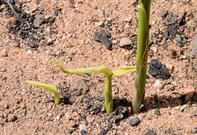Crop Rotation
Crop rotation is advised to counter the build-up of pests. It is not necessary if the land is required on an ongoing basis to produce ginger and if a proper crop protection program is followed to combat these pests and diseases.
Yield - tonnes per hectare
Conservative: 20 tonnes Average: 35 tonnes Good: 50 tonnesHarvesting
Harvesting of mid-season ginger is normally at the start of Autumn in April and May and late ginger in June and July when the plant’s leaves have died back and dried.
Harvesting of mid-season and late ginger is normally done mechanically with a potato lifter. All the rhizomes must be harvested because they will start to grow again when the weather starts to warm up again.
Early ginger that is needed for preserves and needs to have no fibre is harvested after five months from planting by hand to not damage the rhizomes. This is normally during February in South Africa.
Storage
As fresh ginger is very perishable the ginger rhizome is cured after harvest by forcing warm air through the crates or bins. Curing takes about one week. Storage of ginger can be done successfully for up to 12 months.
Storage temperature should be 15°C at a relative humidity of 80%. Pests and diseases associated with ginger production varies throughout the many production areas around the world. Some common problems are mentioned below.